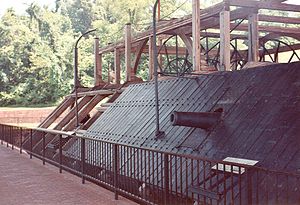Casemate ironclad
As the guns were carried on the top of the ship yet still fired through fixed gunports, the casemate ironclad is seen as an intermediate stage between the traditional broadside frigate and modern warships.
The casemate was heavily armored (later Confederate ironclads had three layers of 2 inches (5.1 cm) steel) over heavy wood backing[1] and was sloped to deflect direct hits (a 35-degree angle quickly becoming standard).
[4] The casemate ironclad being steam driven, either by screws or by paddle-wheels, it did not need sails or masts, although sometimes, when not in combat, temporary pulley-masts, flagpoles, davits, and awnings were added.
In effect, the Confederacy concentrated its efforts on casemate ironclads as a means to harass the Union blockade of their ports, but this was a choice dictated by available technology and materials rather than by confidence in the possibilities of this type.
[citation needed] In their specific outer appearances, i.e. being essentially floating gun batteries encased in armored citadels, albeit powered, the low-freeboard Union and Confederate casemate ironclads were almost uniquely North American.
French examples included Brasil (casemate, and as the name implies, completed for the Brazilian Navy in 1865, and, when stripped of its masts, sharing a striking side-profile similarity with its Confederate progenitors) and Redoutable (barbette, and the first warship in history to be constructed in steel in 1878, instead of iron).
The other example concerned the Royal Dutch Navy ship-of-the-line Zr Ms De Ruyter, whose conversion into an "armoured steam battery" – completed in 1865 – was ordered immediately after the Battle of Hampton Roads, much like the Merrimack's into Virginia, and suffered from the same defects.
Still, all admiralties concluded that it was an evolutionary dead-end and that the revolving gun turret was the way to go – the validity of the conclusion being amply hammered home when the revolutionary HMS Dreadnought (1906) entered service, rendering everything that went before obsolete overnight.


